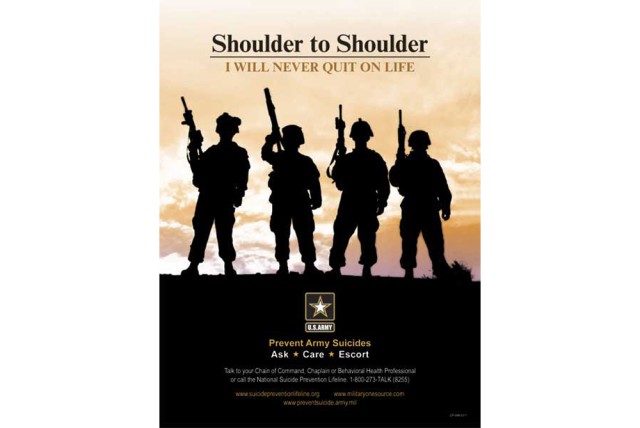HAMPTON, Va., March 25, 2011 -- A new study commissioned by the Defense Department affirms many of the suicide-prevention efforts being made within DoD and the military services and recommends ways to strengthen them.
In preparing "The War Within: Suicide Prevention in the U.S. Military," the Rand National Defense Research Institute examined data on military suicides, identified what scientific literature and leaders in the field consider the best prevention strategies and recommended ways to ensure existing programs reflect the state of the art, officials said.
"This is a very thorough effort," Dr. Mark Barnes, director of the resilience and prevention directorate at the Defense Centers of Excellence for Psychological Health and Traumatic Brain Injury, said of the report. "Rand interviewed each of the services and went outside the military to look at suicide-prevention practices and identified gaps for the way ahead [and] recommendations for the military suicide-prevention programs."
The study's findings track closely with those in the Defense Department's own DoD Suicide Task Force Report, Barnes told military health care professionals attending the first Armed Forces Public Health Conference held here this week.
"There is no disagreement. They are very complimentary in what they are recommending," he said. "So we have a nice resource here with quality information that our suicide-prevention folks can refer to as we move forward with the task force recommendations."
Navy Capt. Paul Hammer, director of the Defense Centers of Excellence for Psychological Health and Traumatic Brain Injury, called the Rand report an important tool in helping the Defense Department better confront an issue it takes "very seriously."
"The Rand study helps us to identify areas that need improvement so that we can continue to provide the most comprehensive health care for our servicemembers - from the inside out," he said.
The study, written for health policy officials and suicide-prevention program managers, recognized critical factors in a comprehensive prevention program. These include:
- Raising awareness and promoting self-care
- Identifying people at high risk, including screening for mental health problems
- Eliminating actual or perceived barriers to quality behavioral health care
- Providing high-quality mental health treatment and specific interventions focused on suicide when needed
- Restricting access to firearms and other lethal means, with attention to how lethal medications are packaged and how door hinges and shower rods are constructed
- Responding appropriately when suicides occur
Evaluating the Defense Department's suicide prevention programs, the study cited the potential benefit of a new DoD-wide surveillance program being used to track suicides and suicide attempts. The DoD Suicide Event Report replaced each service's individual suicide-reporting system, Barnes explained, helping to ensure "apples to apples" comparisons as information is shared across the services.
"This is a data issue," he said. "We need good data. The data informs us in how to be effective with prevention and health promotion. So we are continually improving our data systems."
Rand also called for an evaluation of existing suicide prevention programs, along with a requirement that any new initiatives include an evaluation plan. Barnes acknowledged the challenge of assessing programs' effectiveness, but called closer collaboration and information sharing across the Defense Department and services a positive step toward sharing best practices and determining what works.
The Rand study recognizes most military suicide-prevention programs' focus on raising awareness, including telling people where to get help and helping them recognize peers in distress. However, it emphasizes the importance of also teaching military members how to recognize their own problems and refer themselves if needed to a behavioral health professional or chaplain.
"Raising awareness and promoting self-care is something we do and we can do better," Barnes said, noting the value of resilience campaigns. "The ideas is to give people skills," and know how to recognize signs of risk in themselves as well as others, and to know what to do.
The report also identified the importance of partnerships between agencies and organizations responsible for mental health and substance use and other known risk factors for suicide.
"We do fairly well in terms of partnerships," Barnes said. "One area we are looking at is, on an installation, how well do all the different partners work together in the suicide [prevention] mission' Because often times you have one person who is the suicide prevention person on an installation. They are not going to be able to check in on everybody. It is really the whole installation that needs to be on board to be effective with this."
The study also cited the need to ensure there's no gap in services provided during military members' transitions between military bases, between commands or between active and Reserve status.
"Ensuring a continuity of services and care is really important," Barnes said. "One of the times of increased vulnerability is during transitions, and we need to be covering all the gaps like this proactively for our servicemembers and their families."
The study called for formal guidance for commanders so they know how to respond to suicide and suicide attempts. It recognized the lack of any direct policy within the services and the risks of handling these situations improperly.
"It is really about our leadership," Barnes said. "We need to empower our leadership, because they set the example. They set the tone. So we have to give them the tools. We need to give them the information, the data, so they know what is going on, where we think is the right direction to go, and then get behind them."




Social Sharing